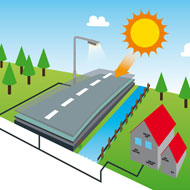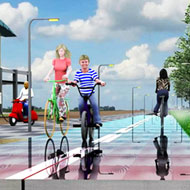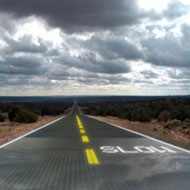Background
SolaRoad, a road covered with energy-generating solar panels, is scheduled to be installed on several miles of bicycle path in the town of Krommenie in northern Holland in 2012. TNO, a Dutch company who developed the SolaRoad, is working with the Province of North Holland, the consulting firm Ooms Averhorn Group, and the technology firm Intech, on this pilot program, hoping to expand the project throughout the country after a 5-year testing period.
SolaRoad consists of concrete panels (1.5 by 2.5 meters) with embedded thick crystal silicon solar cells, covered by a toughened glass surface. The smart ICT applications will maximize energy retention during peak sunlight times and efficiently store it during low-light periods. The energy produced from the road will be used to power streetlights, stoplights, and household appliances. It is estimated that the Dutch road network is comprised of 85,000 miles of roadway with the potential for generating 54 kWh per square yard. The pilot study will determine how the energy will be used and how smart ICT applications can enable the energy produced in peak sunlight periods to be distributed as efficiently as possible during the periods of little or no light.
Proposed US Solar Roadway
A solar-powered roadway is an idea of Scott Brusaw, a 53-year-old electrical engineer in tiny Sagle, Idaho. It is made from super-strong glass, instead of conventional asphalt or concrete. Solar cells inside its glass surface allow the roadway to act as a solar power generator. Electricity generated by the highway could be used to recharge electric vehicles and to power lights and LED warning signs along the road itself (Ligget 2010).
Solar Powered Road Studs, UK
Solar powered road studs automatically illuminates from dusk to dawn with its built in solar-powered light-emitting diode (LED). The studs deliver greater visibility of the road layout ahead, and thus have reduced road accidents by over 70% at their UK installation sites (Astucia).
Lessons Learned
Potential Benefits:
- Generates sustainable electricity.
- Minimizes the need for space for electricity generation and transmission.
- Reduces carbon dioxide emissions.
- Can be applied to bicycle paths, arterial roads, or highways to generate energy.
Potential Issues:
- Under development: Engineering, material selection, energy distribution, (social) business model and user criteria (safety, comfort) are still in the process of development. The pilot study began with a bicycle path because there are fewer traffic needs and requirements.
- Needed criteria: More criteria are needed for stiffness and maintenance (TNO).
- Cost: SolaRoad is profitable in 5-8 years in the Netherlands and in 4-5 years in southern Europe.
Sources
Astucia. “SolarLite Embedded Flush Studs” (http://www.astucia.co.uk/products/product-details?categoryid=176892&productid=176893)
Cardoni, Salvatore, 2011. “Coming to Krommenie, Holland: Solar-Paneled Bicycle Paths” (http://www.takepart.com/article/2011/01/31/coming-krommenie-holland-solar-paneled-bicycle-paths)
Davies, Alex, 2011. “Dutch To Build Solar Panels Into Their Roads, Starting With Bike Lanes.”
Liggett, Britt, 2010. “Energy Generating, Self-Heating Solar Roadway Unveiled” (http://inhabitat.com/energy-generating-self-heating-solar-roadway-unveiled/)
TNO. “SolaRoad Combines Road and Solar Cells” (http://www.tno.nl/content.cfm?context=thema&content=inno_case&laag1=895&laag2=912&item_id=1234&Taal=2)
Treehugger (http://www.treehugger.com/clean-technology/dutch-to-build-solar-panels-into-their-roads-starting-with-bike-lanes.html)
Photo Sources
MIG, Inc.



